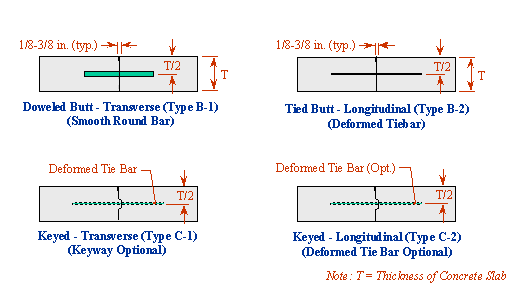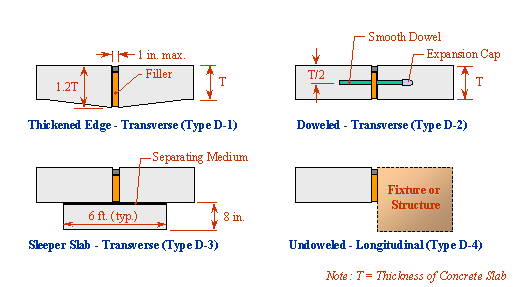Joints
There are three basic joint types used in concrete pavement: contraction, construction and isolation. Specific design requirements for each type depend upon the joint's orientation to the direction of the roadway (transverse or longitudinal). Another important factor is load transfer. Except for some isolation joints, all joints provide a means to mechnically connect slabs. The connection helps to spread a load applied on one slab onto slabs along its perimeter(s). This decreases the stress within the concrete and increases the longevity of the joint and slab(s). The efficiency of the mechanical connection is expressed as load transfer efficiency.
Contraction Joints
Contraction joints are necessary to control natural cracking from stresses caused by concrete shrinkage, thermal contraction, and moisture or thermal gradients within the concrete. Typically transverse contraction joints are cut at a right angle to the pavement centerline and edges. However, some agencies skew transverse contraction joints to decrease dynamic loading across the joints by eliminating the simultaneous crossing of each wheel on a vehicle’s axle. Contraction joints are usually sawed into the concrete, but they might be formed or tooled on smaller projects. The details below show the different types of contraction joints and their dimensions.

Construction Joints
Construction joints join concrete that is paved at different times. Transverse construction joints are necessary at the end of a paving segment, or at a placement interruption for a driveway, cross road or bridge. Longitudinal construction joints join lanes that are paved at different times, or join through-lanes to curb and gutter or auxiliary lanes. The details below show the different types of construction joints and their dimensions.

Isolation Joints
Isolation joints separate the pavement from objects or structures, and allow independent movement of the pavement, object or structure without any connection that could cause damage. Isolation joints are used where a pavement abuts certain manholes, drainage fixtures, sidewalks and buildings, and intersects other pavements or bridges. The details below show the different types of isolation joints and their dimensions.



